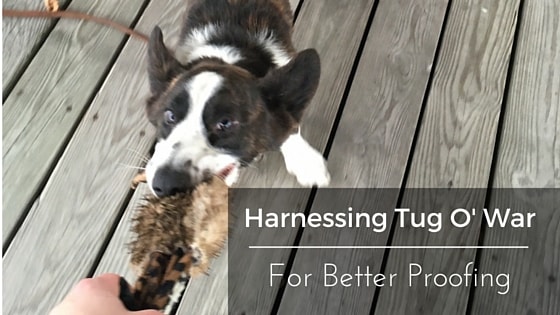Tug O’ War Learning
Do you find some clients saying: “I just want my dog to calm down”? I often think they are really saying they wish their dog would listen to them rather than lose their spunk or nuttiness. Often times when dogs are aroused by their environment be it a squirrel, another dog or a human, the behaviors that they know well in their day-to-day life such as sit and down, go right out the window because they’re so aroused and excited.
As a trainer we can help their brains comprehend what arousal feels like so that the pup can perform all his basic tasks when aroused. Tug-of-War is a tried and true way to teach impulse control when aroused. It is incredibly important as a trainer to watch the dog’s behavior change as you tug and to remember that in the beginning it can be pretty intense for the pup, so taking breaks to reduce stress from the intensity is also key.
Darth Vader vs. Luke Skywalker
Tug-of-War can sometimes be viewed as the Darth Vader of games for dogs; designed to encourage aggression, when in fact it isn’t evil at. Take it from me: if tugging made dogs aggressive then I would have the most aggressive dogs on earth. When tugging is used properly it serves as a game of bonding between you and your client’s pup. Tugging can be used as a wonderful tool to create what I call “synthetic arousal”. Granted; arousal is arousal, but when we can incite it through tugging, arousal can help proof the behavior and make your client’s dogs super solid!
Dress Rehearsal
It’s probable that the directions and exercises we give our clients to practice throughout the week will be rehearsed in a quiet and safe area. They often choose spaces such as their living room or bedroom, which are good starts but can tend to act like a vacuum. If they rarely push their pup to practice new behaviors in more stimulating environments, the tendency is that is the dog can only perform the behavior in a quiet and calm area.
So, how do we take the show on the road? Enter, stage left: Tugging.
Establishing the rules to this kind of play first is of utmost importance. A good trainer first must institute the ground rules around mouthing, choking up on the toy, and jumping—teaching clearly what’s prohibited. Making sure too that the dog will drop the toy on cue is an example of the small, yet critical pieces of impulse control necessary for easy and successful arousal training. I’ll often make simple adjustments when unwanted behavior arises such as dropping the toy mid-game and walking away—remembering that I’m the one making the toy dance and without me it’s just a rag on the floor.
Just Before the Curtain Goes Up
After your client’s dog has the foundation of tugging with rules, it’s time to move on to doing a type of circuit training where basic commands such as sit, down, stay, and leave it are added to the tugging games. Prime the pump by asking your client’s dog to sit a few times rewarding each time with food. Then present the tug toy and tug with the pup for a short time. Follow by asking for a drop and a few sits. If you notice that the pup has some difficulty sitting or holding a sit because they are aroused, slow down on the tugging, as this is no different than fine-tuning the equalizer on a Hi-Fi stereo.
Opening Night
Just as all successful performances are the result consistent and fun rehearsal after rehearsal, we know that dog-play is no different. The circuit training allows for dogs to continue thinking even when they are aroused. With this type of training you’ll be setting them up for amazing amounts of success where they will be able to do more than just stay at home. They’ll probably even lose the old title of “crazy” and maybe even be nominated for an Oscar.
How will you be using tugging in your training?
Get Dog Training Business Tips!
Receive valuable dog training business tips and resources every week! Subscribe to The Modern Dog Trainer now by submitting your name and email below.
[mc4wp_form]




